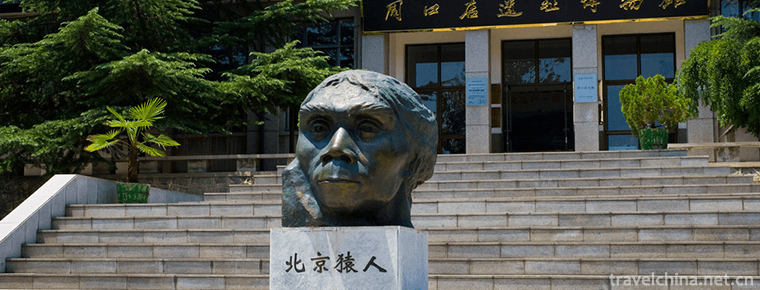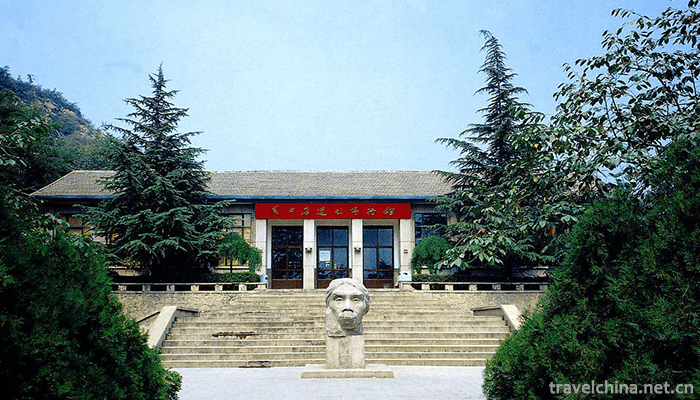2019-01-02

- By ChinaWiki.net
- Chinese Edition
- 2019-03-20
Peking Man Site at Zhoukoudian
Zhoukoudian Peking Man Site, located in Longgu Mountain, Fangshan District, Beijing, is an important Paleolithic site in China. Since 1927, three complete skulls and some remnants have been found in the cave, which is the site of the discovery of Peking ape man and cave man. Cavemen represent the type of newcomers more than 10,000 years ago. They are important material materials for the study of human evolution. Since the founding of the People's Republic of China, new materials such as Peking ape-man fossils, stone tools and fire relics have been discovered successively, which are extremely valuable materials for studying the history of human development and the history of primitive Chinese society. It was included in the World Heritage List in 1987.
Excavation process
In 1918, Zhoukoudian was first discovered at the sixth place, which was discovered by Swedish scientist Ant.
From 1921 to 1927, archaeologists discovered three human tooth fossils outside the cave site of Peking Man three times.
In 1921, Anteson, American paleontologist Glendar and Austrian paleontologist Stensky discovered the 1st site of Zhoukoudian, and the 2nd site of Zhoukoudian in the same year.
In 1927, Bu Dasheng officially named the three human teeth found in Zhoukoudian as Chinese ape-man Beijing species. This year, the official site of Zhoukoudian began to be excavated. Li Jie, a Chinese geologist, took part in the excavation and discovered the 3rd and 4th sites of Zhoukoudian.
In 1929, Pei Wen found the 5th, 7th and 8th sites, the first skull of the "Peking Man", the skull fossils of the Peking Man, the artificially made tools and the relics of fire.
In 1930, fossils and cultural relics of cave dwellers were also found at Zhoukoudian site about 20,000 years ago.
The Zhoukoudian Site Museum was built in 1953.
The discovery of "Xindong Man" in 1973 between the two eras indicates the continuation and development of Peking Man.
In 1971, the Chinese Academy of Sciences allocated special funds for expansion and renamed it "Peking Ape Man Exhibition Hall".
After the founding of New China, the excavation of the Zhoukoudian site was resumed, and a great deal of valuable information was obtained. So far, archaeologists have unearthed the skull, mandible, teeth and other stones representing more than 40 corpses, as well as abundant stone tools, bones, horns and fires.
The World Heritage Committee of UNESCO approved the Peking Man Site in Zhoukoudian as a world cultural heritage site in December 1987.
geographical environment
Location context
Zhoukoudian Peking Man Site is located in Longgu Mountain, Zhoukoudian, Fangshan District, Beijing. It's about 50 kilometers from Beijing.
topographic features
Zhoukoudian Site lies on the back of the undulating Taihang Mountains, facing the vast North China Plain. A small river in front of Zhoukoudian Site flows by. It is rich in natural resources and has a warm and pleasant climate. It is the place where Peking ape man lived 500,000 years ago, Xindong man 10-200,000 years ago and cave man lived 10-30,000 years ago.
Remains of cultural relics
Peking ape-man fossils have unearthed 6 skulls, 12 skull fragments, 15 mandibles, 157 teeth, broken femur and tibia, belonging to more than 40 male, female, old and young individuals. 100,000 pieces of stone materials and burnt ashes, burned stones and bones were found.
Since the large-scale systematic excavation of Zhoukoudian Site in 1927, 27 sites of various fossils and cultural relics have been found in different periods. More than 40 fossil remains representing "Beijingers", more than 100,000 stone tools, nearly 200 animal fossils and a large number of fire relics have been unearthed. They have become world-famous treasure houses of human fossils and paleoanthropology, archaeology, Paleobiology and stratigraphy. A comprehensive multi-disciplinary research base including chronology, environmental science and karst science.
At the top of Longgu Mountain, fossils of ancient humans were excavated in 1930, which lived around 20,000 years ago and were named "caveman on the top of the mountain".
Through the study of these archaeological data, it is proved that Peking ape-man has created a distinctive Paleolithic culture about 69,000 years ago, which has a far-reaching impact on the development of Paleolithic culture in North China. The discovery of Peking Ape Man has also advanced the history of using fire hundreds of thousands of years, leaving a thick pile of ash in the caves where they lived.
The seven major world cultural heritages in Beijing are: Zhoukoudian Peking Ape Man Site, the Forbidden City, the Great Wall, the Summer Palace, the Temple of Heaven, the Ming Tombs and the Grand Canal.
Site value
The Value of Social Development
According to the study of human skeleton fossils, stone tools and fire relics in Beijing, archaeologists believe that Peking people lived between 700,000 and 200,000 years ago. Beijingers have an average brain size of 1088 milliliters and primitive head features, but they have obvious characteristics of modern Mongolian races. Males are about 156 centimeters tall and females are about 144 centimeters tall. Food mainly comes from hunting and gathering. Peking people already know how to use fire and eat cooked food. Fire is mainly taken from nature. They know how to protect fire. The use of fire is a complete feature of people. The discovery of Beijingers laid a foundation for the study of ancient Chinese people and their culture.
Historical and Cultural Value
The discovery of Beijingers has provided beneficial evidence for the theory of human evolution and is a great contribution made by Chinese scientists to the World Archaeological history. The discovery and study of Peking Man and its culture have settled the controversy about whether Homo erectus is an ape or a human since the discovery of Javans in the 19th century. Facts have proved that "Homo erectus" is the earliest period of human history, in the most important part of the evolution process from apes to humans. They are descendants of "Australopithecus" and later ancestors of "Homo sapiens". Beijingers have the typical morphological standard of "Homo erectus", and the use of fire by Beijingers has perfected their characteristics as human beings. The discovery of human fossils and cultural relics in the cave on the top of the mountain fully demonstrates the development and continuity of Peking people. The discovery of Beijingers laid a foundation for the study of ancient Chinese people and their culture, and is a well-deserved treasure house of ancient human culture.
Value of Life Development
Through the study of these archaeological data, it is proved that Peking ape-man has created a distinctive Paleolithic culture about 69,000 years ago, which has a far-reaching impact on the development of Paleolithic culture in North China. Stone tools are the main representatives of "Peking people" culture. Peking people created three different methods of slicing. They mainly used smashing methods to produce small pieces of stone 20-130 mm long. The common length is 20-40 mm. Tools can be divided into two categories: hammer, hammer and drill, and scraper, pointed tool, chopper, sculptor, Stone Cone and spherical tool.
The discovery of fire relics at site 1 of Zhoukoudian has advanced the history of human use of fire by hundreds of thousands of years. Including five ash layers and two well-preserved ash piles, burnt bones can be found in all layers of human activities. In addition, burned trees, burnt stones and burnt earth blocks, and even some stone tools have burnt traces. From the study of fire relics, we can see that "Beijingers" not only know how to use fire, but also have the ability to control and preserve fire. The fuel used for the fire is mainly herbs, but also branches and fresh bones.
Protection of cultural relics
Zhoukoudian Site Museum was built in 1953. In 1971, the Chinese Academy of Sciences allocated special funds to expand the museum and renamed it "Peking Ape Man Exhibition Hall". The World Heritage Committee of UNESCO approved the Peking Man Site in Zhoukoudian as a world cultural heritage site in December 1987.
In 1961, it was announced by the State Council as the first batch of national key cultural relics protection units; in 1987, it was listed in the first batch of "World Cultural Heritage List" of China by UNESCO; in 1992, it was listed in the Youth Education Base of Beijing; in 1997, the Ministry of Propaganda listed it as one of the 100 national patriotic education demonstration bases; and in 2006, it was awarded the National Youth Science Education Base by the Central Committee of the League; It was appraised as a first-class Museum by the State Administration of Cultural Relics in 1998.
Tourism information
Folding tickets
30 yuan (half price for students)
Folding Open Time
8:30-16:30 (closed day)
Folding traffic
Take No. 917 bus from overpass to Zhoukoudian, or get off at Fangshan and transfer to No. 38.
Scenic spot
Zhoukoudian Site is divided into two parts: the site area and the museum, which are open to the audience all the year round. There are many fossil sites such as the famous ape-man cave, the new cave and the cave on the top of the mountain. The museum contains seven exhibition halls, which contain a large number of precious cultural relics, animal fossils and stone tools. The historical value and cultural connotation of Zhoukoudian site are explained to the audience in the form of pictures and texts.


Ask a Question
Your email address will not be published.


0 Questions